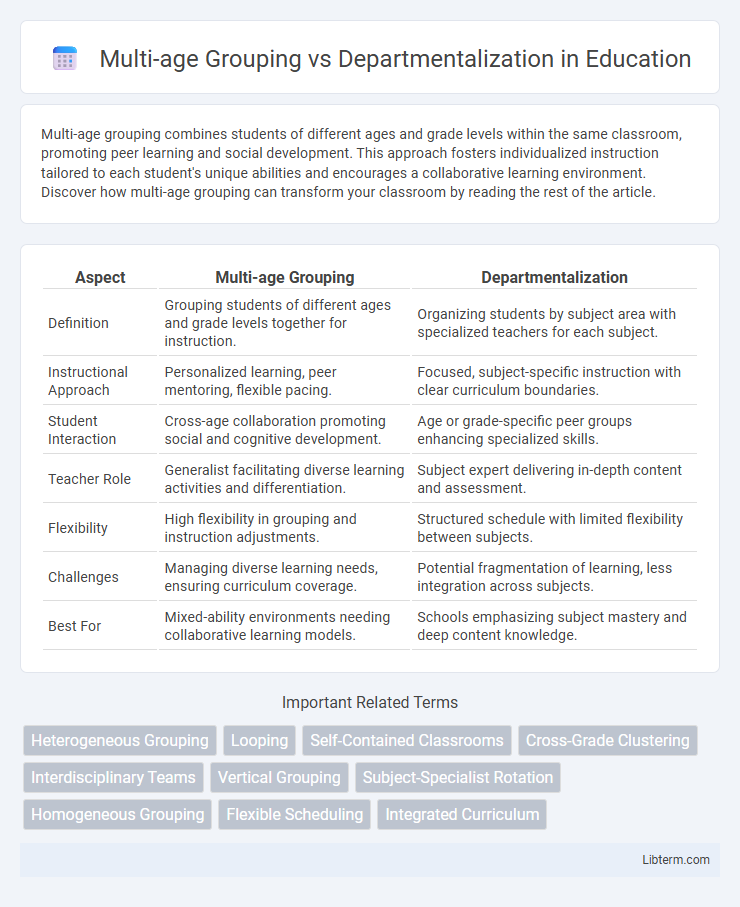Multi-age grouping combines students of different ages and grade levels within the same classroom, promoting peer learning and social development. This approach fosters individualized instruction tailored to each student's unique abilities and encourages a collaborative learning environment. Discover how multi-age grouping can transform your classroom by reading the rest of the article.
Table of Comparison
| Aspect | Multi-age Grouping | Departmentalization |
|---|---|---|
| Definition | Grouping students of different ages and grade levels together for instruction. | Organizing students by subject area with specialized teachers for each subject. |
| Instructional Approach | Personalized learning, peer mentoring, flexible pacing. | Focused, subject-specific instruction with clear curriculum boundaries. |
| Student Interaction | Cross-age collaboration promoting social and cognitive development. | Age or grade-specific peer groups enhancing specialized skills. |
| Teacher Role | Generalist facilitating diverse learning activities and differentiation. | Subject expert delivering in-depth content and assessment. |
| Flexibility | High flexibility in grouping and instruction adjustments. | Structured schedule with limited flexibility between subjects. |
| Challenges | Managing diverse learning needs, ensuring curriculum coverage. | Potential fragmentation of learning, less integration across subjects. |
| Best For | Mixed-ability environments needing collaborative learning models. | Schools emphasizing subject mastery and deep content knowledge. |
Understanding Multi-Age Grouping
Multi-age grouping involves organizing learners of different ages together to promote peer learning, cognitive diversity, and social development across age ranges. This approach contrasts with departmentalization, which separates students primarily by subject or age into distinct classrooms or departments to specialize instruction. Understanding multi-age grouping highlights its benefits in fostering collaboration, individualized pacing, and adaptability compared to the rigid, segmented structure of traditional departmentalization.
Defining Departmentalization in Education
Departmentalization in education organizes schools into specialized units based on subjects such as math, science, or language arts, enhancing instructional focus and resource allocation. Unlike multi-age grouping, which integrates students from different grades for social and cognitive benefits, departmentalization prioritizes teacher expertise and curriculum depth within each subject area. This structure supports targeted professional development and streamlined assessment practices aligned with specific academic disciplines.
Historical Context and Evolution
Multi-age grouping emerged in early 20th-century educational reform as a response to rigid age-based classrooms, promoting individualized learning and social development across age ranges. Departmentalization originated in industrial-era organizations, enhancing specialization by dividing work into functional units, which improved efficiency and expertise. Over time, educational institutions have adapted elements of departmentalization for subject-focused teaching while maintaining multi-age group benefits in progressive models.
Key Benefits of Multi-Age Classrooms
Multi-age classrooms enhance social development by promoting peer learning and collaboration across different age groups, leading to improved communication skills and empathy. They support individualized instruction tailored to diverse learning paces and styles, which fosters academic growth and self-confidence. This grouping strategy also encourages leadership opportunities and mentorship among students, creating a dynamic and supportive educational environment.
Advantages of Departmentalized Teaching
Departmentalized teaching promotes subject specialization, allowing educators to develop deeper expertise in their assigned disciplines, which enhances instructional quality and student understanding. This approach facilitates improved resource allocation and curriculum alignment, ensuring consistent learning outcomes across grade levels. Additionally, departmentalization encourages collaboration among teachers within the same subject area, fostering professional development and innovative instructional strategies.
Challenges Faced by Multi-Age Grouping
Multi-age grouping presents challenges such as managing diverse developmental levels and varying academic needs within a single classroom environment, complicating curriculum planning and individualized instruction. Teachers often struggle with balancing attention and resources effectively to support both advanced learners and those requiring remediation. Furthermore, social dynamics can become complex, requiring strategies to foster collaboration and minimize age-related conflicts.
Drawbacks of Departmentalization
Departmentalization can lead to communication barriers and reduced flexibility due to rigid group boundaries separating employees by function or product. It often causes duplication of efforts and resource inefficiencies as departments prioritize their own goals over organizational collaboration. This structure may inhibit innovation and slow decision-making processes, limiting responsiveness to dynamic market conditions.
Impact on Student Social and Emotional Development
Multi-age grouping fosters peer learning, empathy, and collaboration by allowing students of varying ages to interact regularly, which enhances emotional intelligence and reduces social anxiety. Departmentalization, while promoting specialized instruction and academic rigor, may limit students' social interactions primarily to age-similar peers, potentially hindering the development of diverse social skills. Research indicates that multi-age settings contribute to stronger social cohesion and emotional resilience, benefiting long-term student well-being.
Academic Outcomes: Comparing Both Approaches
Multi-age grouping enhances academic outcomes by promoting peer learning and social development across different ages, leading to improved critical thinking and collaborative skills. Departmentalization organizes students by specific subject expertise, allowing for focused instruction and deeper content mastery, particularly in advanced or specialized courses. Studies show multi-age grouping boosts engagement and adaptability, while departmentalization excels in standardized test performance and subject proficiency.
Choosing the Best Model for Your School
Choosing the best organizational model for your school depends on balancing diverse student needs with instructional efficiency. Multi-age grouping promotes peer learning, social skills development, and individualized pacing, improving engagement and collaboration. Departmentalization enhances subject specialization and teacher expertise, streamlining curriculum delivery but may reduce personalized interaction; evaluating school size, resources, and educational goals guides the optimal choice.
Multi-age Grouping Infographic

 libterm.com
libterm.com